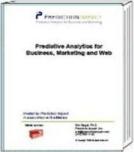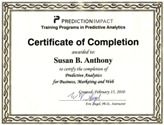What is predictive analytics?
Business metrics do a great job summarizing the past. But if you want to predict how customers will respond in the future, there is one place to turn — predictive analytics. By learning from your abundant historical data, predictive analytics provides the marketer something beyond standard business reports and sales forecasts: actionable predictions for each customer. These predictions encompass all channels, both online and off, foreseeing which customers will buy, click, respond, convert or cancel. If you predict it, you own it.The customer predictions generated by predictive analytics deliver more relevant content to each customer, improving response rates, click rates, buying behavior, retention and overall profit. For online applications such as e-marketing and customer care recommendations, predictive analytics acts in real-time, dynamically selecting the ad, web content or cross-sell product each visitor is most likely to click on or respond to, according to that visitor's profile. This is AB selection, rather than just AB testing.
Predictive Analytics for Business, Marketing and Web is a concentrated training program that includes interactive breakout sessions and a brief hands-on exercise. In two days we cover:
- The techniques, tips and pointers you need in order to run a successful predictive analytics and data mining initiative
- How to strategically position and tactically deploy predictive analytics and data mining at your company
- How to bridge the prevalent gap between technical understanding and practical use
- How a predictive model works, how it's created and how much revenue it generates
- Several detailed case studies that demonstrate predictive analytics in action and make the concepts concrete
- NEW TOPIC: Five Ways to Lower Costs with Predictive Analytics
Who this seminar is for:
Managers. Project leaders, directors, CXOs, vice presidents, investors and decision makers of any kind involved with analytics, direct marketing or online marketing activities.In order to meet the unique training needs of business decision makers and analytics practitioners, this training program is:
Marketers. Personnel running or supporting direct marketing, response modeling, or online marketing who wish to improve response rates and increase campaign ROI for retention, upsell and cross-sell.
Technology experts. Analysts, BI directors, developers, DBAs, data warehousers, web analysts, and consultants who wish to extend their expertise to predictive analytics.
- Business-focused. Unlike other training programs that also cover scientific, engineering and medical applications of data mining and analytics, this seminar focuses squarely on solving business and marketing problems with these methods.
- Comprehensive across business needs. Within this realm, however, we step beyond the standard application of response modeling for direct marketing to solve the wider range of business problems listed below.
- Vendor-neutral and method-neutral. This training program, which is not run by an analytics software vendor, provides a balanced view across analytics tools and methods.
- Solving business problems with predictive analytics Predictive analytics solves many business problems, offering solutions such as:
- Increased customer retention by predicting defection
- Increased online conversions and ad takes by predicting clicks
- Increased sales and acquisition rates by predicting cross-sell opportunities
- Personalized web and email content by predicting online response
- Greater relevancy by predicting customer needs
- Increased direct marketing response with response modeling
- Decreased campaign spending by predicting non-responders
- Increased fundraising profit by predicting donations
- Higher-valued acquisitions by predicting customer lifetime value
- Creating predictive models Data is your most valuable asset. It represents the entire history of your organization and its interactions with customers. Predictive analytics taps this rich vein of experience, mining it to produce predictive models. Where multi-channel data is available, predictive analytics discovers interactions across customer touch points, such as key online behavior that may predict which customers will respond to direct mail.
Whatever the application, the core methodology of predictive modeling is the same. We will uncover, in concrete terms, how modeling transforms your data into actionable customer predictions. To this end, we will see exactly what a model is, taking a look inside to see how it works and how it is created. Then we will:
- Explore several example models in action
- Turn the knobs that tweak and control modeling
- Compare and contrast modeling methods intuitively, visualizing their differences so it all makes sense:
- Decision trees
- Business rules
- Naive Bayes
- Linear regression
- Logistic regression
- Neural networks
- Other more recent advanced modeling techniques
In addition to the products demonstrated, we will discuss the full spectrum of today's predictive analytics software, including free tools, cheap tools, and complete software suites. - Measuring how well predictive models work Once you've got a predictive model, how do you know how good it is? We cover methods to evaluate models, which fall into two groups:
Forecasting: How large a boost in revenue, sales or profit will the model produce?
Deploying a predictive model is playing a numbers game that puts the odds in your favor and improves the effectiveness of campaigns, operations and web behavior. We create profit curves, ROI calculations and bottom-line analyses and talk through exactly what they're telling us. And we prepare for performance gotchas that sneak up on you.
Accuracy: How well does it predict, how often is it correct, and how much better is it than standard segmentation such as RFM? - Management and project leadership for predictive analytics Although predictive analytics is technical at its core, it must be run as a business activity in order to generate customer predictions that have a business impact. This requires a wholly collaborative process driven by business needs and marketing expertise. This ensures that customer predictions are actionable within your company's operational framework, and that they have the greatest impact within your company's business model.
Referencing the industry standard data mining process model (called CRISP-DM), we break down the requirements of a predictive analytics business initiative. We explore this process, by which analysts and managers collaborate to strategically position predictive analytics, sustain universal buy-in and understanding, and avoid common roadblocks and unforeseen hazards.
These engaging breakout sessions are conducive to exercising the concepts you've learned, making them more intuitive and ingrained, and also provide an opportunity to learn from colleagues.
You will also "get your hands dirty" by digging through some data with a hands-on exercise during the second day. Optionally working with a buddy for this short exercise of about 20 minutes, you will bring a predictive model to life and see it improve before your eyes.
Course information and registration
Attendees receive a course materials book and an official Prediction Impact certificate of completion at the conclusion of the Predictive Analytics for Business, Marketing and Web training program.
 (Click to zoom)
(Click to zoom) Course materials book Certificate of completion
See training seminar registration for course venue information, registration, and the $100 early-bird discount.
Feel free to contact Prediction Impact with any questions about this training program.
Start learning right now
The following short, published articles, written by the instructor, are a great place to get started. Note that these articles are not required reading; the material therein will be covered during the training program.Predictive Analytics with Data Mining: How It WorksSneak preview video. View the 13-minute video overview of our online training program, which is largely descriptive of this in-person training seminar as well.
Get a handle on the functional value of predictive analytics for marketing, sales and product direction. DM Review's DM Direct
Driven with Business Expertise, Analytics Produces Actionable Predictions
Run data mining as a business activity to generate customer predictions that will have a business impact. CRM Magazine's DestinationCRM.
Predictive Analytics' Killer App: Retaining New Customers
Predictively targeted discounts convert new customers who would otherwise never return to become loyal customers. DM Review's Extended Edition.
 Eric Siegel, Ph.D., is a seasoned consultant in data mining and analytics, an acclaimed industry instructor, and an award-winning teacher of graduate-level courses in these areas. Eric served as a computer science professor at Columbia University, where he developed data mining technology in the realms of machine learning performance optimization, integrating historical databases, text mining, and data visualization. The conference chair of Predictive Analytics World, Eric has authored 11 peer-reviewed research publications and ran an MIT-hosted symposium on data mining. He also co-founded two New York City-based software companies for customer/user profiling and data mining. With data mining, Eric has solved problems in CRM analytics, computer security, fraud detection, text mining and information retrieval.
Eric Siegel, Ph.D., is a seasoned consultant in data mining and analytics, an acclaimed industry instructor, and an award-winning teacher of graduate-level courses in these areas. Eric served as a computer science professor at Columbia University, where he developed data mining technology in the realms of machine learning performance optimization, integrating historical databases, text mining, and data visualization. The conference chair of Predictive Analytics World, Eric has authored 11 peer-reviewed research publications and ran an MIT-hosted symposium on data mining. He also co-founded two New York City-based software companies for customer/user profiling and data mining. With data mining, Eric has solved problems in CRM analytics, computer security, fraud detection, text mining and information retrieval.Eric has taught industry programs through Prediction Impact, The Modeling Agency and Salford Systems. In addition, he taught many semesters of university courses, including data mining-related graduate courses as well as introductory lecture series for non-technical audiences. Two of these courses have been in syndication through the Columbia University Video Network. Eric also published three peer-reviewed papers on computer science education.